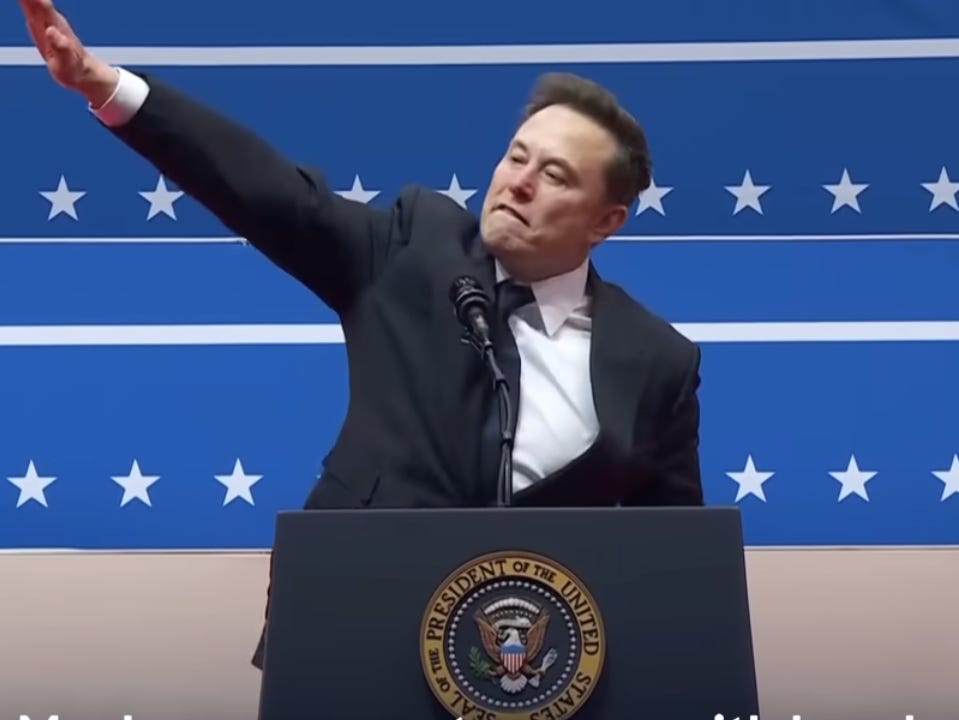
“Liberal delusions.”

Two images, their truth.
In reality, only the fragment carries the mark of authenticity.
— Brecht.
22 APRIL—Peter Dimock, the avant-garde novelist (A Short Rhetoric for Leaving the Family, George Anderson, Daybook from Sheep Meadow) and an old friend of The Floutist, came to us some time ago with two photographs he proposed we publish. He offered us the briefest of texts, not much more than a paragraph, as he wished the images to speak for themselves.
We were immediately captivated with the power of juxtaposition—what pictures viewed side by side have to tell us, the truths they force upon us when seen together—not only about themselves but about us, we who look at them. This seemed to us Peter’s essential point. We asked merely that he provide an accompanying text without spoiling the effect of images that, taken together, need no mediation.
We are pleased to present this original experiment, as Peter calls it, and to welcome him once again into our pages.
—The Editors.
Peter Dimock
Before going any further with this, a brief experiment in perception and cognition, I ask you to study, side by side, the two images appearing above these words. The first is of Hind Rajab, a six-year-old Palestinian girl who, before she was infamously murdered in her family’s car in January 2024, lived in Gaza City. The second, of course, is of Elon Musk. Please keep track of your reactions to the juxtaposition of these photographs as you read the following paragraphs.
■
I find myself ever more preoccupied with the following question: Within what narrative of American democracy do liberals now place the political events of our destabilized and destabilizing present? Foremost among these events, of course, is the American and Israeli governments’ side-by-side descent into the depraved crimes of genocide and the destruction of international law. The self-evidence and proof of the repetition of genocide through state power—“the crime of crimes”—that unfolds daily in Gaza and occupied Palestine, perpetrated by known officials and personnel of the U.S. and Israeli governments, is available for everyone to witness and respond to in real time.
To watch these events from a position beyond the ideological coercions of American liberalism’s master narrative—a position essential to clear sight—is to understand them the same way the vast majority of the world’s people sees them. Setting aside—escaping, indeed—the universe of American liberal thought, we are witnessing the active destruction of the last vestiges of credibility clinging to America’s orthodox narrative of itself and its global power as an historically redemptive democratic project.
■
American liberalism has always suffered an unresolved contradiction between its professed dedication to market freedoms and its traditional commitment to the universal, collective well-being by way of democratic governance. This contradiction, and the impossibility of resolving it, was brilliantly explored in Charles Sellers’s justly celebrated The Market Revolution (Oxford, 1994). His central point is simple and utterly profound. The Declaration of Independence authorized the American white people’s revolutionary democratic overthrow of their imperial oppressors by way of a specific presumption. This was Jefferson’s noted presumption. He reasoned that a stable, sustainable, agrarian, subsistence, use-value, pre-industrial capitalist social logic was defining of America’s future. This logic, a social logic, was inscribed in the Declaration. We can find it there today.
It is only after 1815 that an opposing logic began to take hold. This version of the American future was made of an unbounded, profit-driven, wholly monetized, proto-industrial, developmental-state model of American capitalism. Sellers writes, and this is absolutely central to his case, “Contrary to liberal mythology, democracy was born in tension with capitalism, and not as its natural and legitimizing expression.” The triumph of American capitalist market society, Sellers argued, was not complete until the 1830s and 1840s.
Since the 1945 victories—or perhaps since the Spanish–American War four and some decades earlier—this irreconcilable contradiction, this knot that cannot be either tied or untied, is simply stated: Americans will have empire abroad or democracy at home, but they will not have both. It is American liberalism’s most fundamental failing that it does not recognize the reconciling of these two national pursuits as delusional.
■
It is very fortunate that this inner contradiction—between justice and the ideology of market-defined capitalist freedom, simply put—has long been recognized by vast numbers of people, domestically and abroad, powerful and powerless, remembered and unremembered. This leads to one of the questions I intend my experiment to press upon us: When will liberals recognize the unresolved inner contradiction by which they live as responsible for their nation’s refusal—or do we speak of a compulsion?—to curb the destructive forces unleashed upon the world by America’s insistence on global hegemony?
This question leads to others: Will liberals affiliated with the Democratic Party acknowledge that liberalism’s post–1945 betrayal and abandonment of democracy for the sake of global hegemony, economic dominance, and American primacy altogether still determines the decision-making and worldview of their party’s political and policy elites?
Will liberals be willing not merely to invoke the “democratic” side of liberalism’s long-ruling contradiction but to overthrow the entire liberal narrative? Will they permit themselves to acknowledge, even to themselves, their inner knowledge that the conventional liberal narrative is neither accurate as history nor adequate as moral grounding for a coherent democratic subjectivity that contributes to a sustainable and universally democratic human polity?
■
In the early days of psychoanalysis, either side of the turn of the twentieth century, diagnosis and treatment of schizophrenia is said to have been furthered by the administration and interpretation of what came to be called the Word Association Test. The patient was asked to produce for the analyst the first word that came to consciousness in response to his, the analyst’s, delivery of a single word from a long list. Carl Jung, among others, believed the Word Association Test gave invaluable access to the mind’s otherwise inaccessible subconscious and unconscious levels of motivation and determination.
The response word given by the patient, the physical and emotional affect accompanying the patient’s delivery of the articulated response, the time it took to respond, and, above all, the analyst’s intuitive understanding of the possible connections between the patient’s responses and underlying constellations (“complexes”) of emotional and psychological meaning were used to discern an etiology or originating source of the patient’s sufferings. The resulting interpretations, derived from a juxtaposition of the associations, gave doctor and patient, it was thought, a possible language of coherent clinical and emotional self-understanding from outside the fragmenting coercions the disease of schizophrenia imposed upon both.
■
The unrelenting persistence of the unavoidable self-evidence of a terrorist state’s genocide and ethnic cleansing, the wanton obliteration of international law, and with this the dismantling of American democracy unfolds daily in “news” images before our eyes and in “real time.” This is an almost hallucinatory experience, perhaps new in modernity’s experience of itself. Maybe “news” images are what Americans now have, more prominently than words, through which we create an historical subjectivity that, all at once, psychologically “processes” and “denies” the history we are living within the same moment of consciousness.
In response, I propose an analogous Image Association Test using the two news images presented atop this essay. Perhaps this experiment will elicit, outside the frame of liberalism’s controlling, self-contradictory master narrative, fragments of a coherent narrative of democratically principled opposition. This is my intent. Surely it is from such fragments of refusal and opposition that another frame for American democracy, responsive to the history we are living and capable of successfully opposing empire and militarized supremacy, will be produced.
For anyone taking the time to self-test by way of this method, I propose the juxtaposition of these two images and your associations, and then a meditation upon the following question: What narrative of American democracy, if any, most accurately and tellingly comes to mind concerning the co-existence of these photographs as images and figurations of contemporary American historical reality?
As a final step, consider what answer you propose to the following question: Given the increasing likelihood that there will be no legal enforcement by any branch of the American government of any statute or treaty commitment to warn, prevent, intervene, cease, prosecute, and punish the perpetrators of crimes of genocide and ethnic cleansing—whether individuals or states and however powerful those persons or states are—why do liberal Democrats now speak and act as if they expect there to be legal consequences for those who are successfully destroying American democracy?
■
I offer this exercise as one way to try to oppose the coercions placed in the way of liberals by the historical and contemporary master narrative of American liberalism. That narrative, I contend, prevents liberals from acting on their existential investment in the question of the present sources of the American state’s illegal assertion and exercise of an exterminatory entitlement to impunity.

